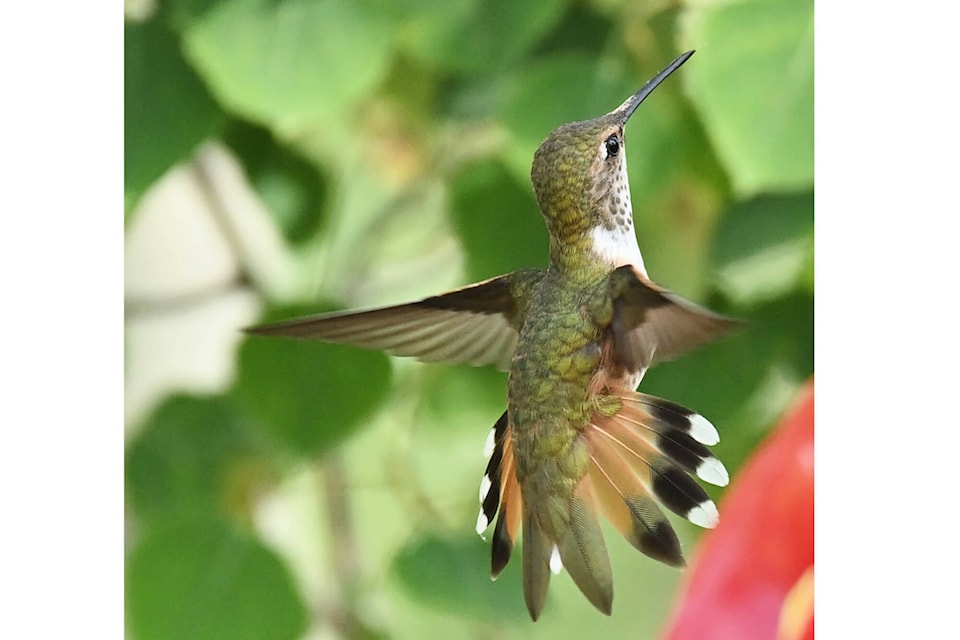Early one morning this summer, as I stepped out the front door of our cabin, a bolt of red streaked by my face so close that my nose was fanned by its wings.
The blur transformed to a spot as the bird briefly hovered at eye-level and abruptly blasted upward as a vanishing spec in the sky. Seconds later, it reappeared as a living missile in a bill-dive aimed directly at the ground. Hollywood-style, it pulled up just at the last moment and immediately started a three-dimensional, figure-eight hover-dance above a female hummingbird hidden in the grass.
Whew, that was an exciting start of the day for both of us!
Hummingbirds never cease to impress. Whether they are sipping nectar from a flower, preforming aerial feats that are literally impossible for any other type of bird, or as they mount a feisty defence of a preferred flower-patch, they are birds that demand attention.
Hummingbirds also are one of the most watched group of birds in the Shuswap as they frequent our fields, forests and backyards from May until late September.
Named after the humming sounds made by their wings, ‘hummers’ have two speeds — full tilt and stopped.
Their unique wing structure allows them to hover and even to fly slightly backwards. They have the highest metabolic rate of any bird and need to be constantly refueling their cells with oxygen. While in flight, heart-rates of over 1,000 beats per minute support their frantic pace and, not surprisingly, hummingbirds have the largest hearts relative to their body weight of any bird.
Flower nectar is sweet, but the sugars are still very dilute so hummers need to feed almost constantly during the daytime. Astonishingly, they drink as much as two to three times their body weight of nectar every day. I sometimes think of that as I struggle to drink my daily recommended eight glasses!
Read more: Video: Large number of hummingbirds surprise Shuswap resident
Read more: Nature Wise: Feeding the hummingbirds
To keep their metabolic engines going, hummingbirds have a unique digestive structure that allows nectar to quickly pass through their stomach and into their small intestine. This speeds sugar absorption into the bloodstream and helps hummingbirds sustain their sugar-injected pace.
Depending on a constant sugar-high during the day, it is no wonder that hummingbirds are always ready to defend a particularly sweet patch of flowers. Of course, they also eat tiny invertebrates (no one can live on sugar alone),but these semi-solid items take a more leisurely and commonplace route through the hummingbird’s digestive tract.
Keeping a constantly high body temperature, particularly high up in the mountains where some of our hummingbirds migrate, poses a nightly challenge for birds that need near-constant refueling. To solve this, some hummingbirds are known to enter a nightly torpor. In this state, their body temperature and heart rate drop, effectively putting their bodies on idle until the morning.
Here in the Shuswap, we regularly see four species of hummingbirds. The most conspicuous is the species that nearly grazed my nose a few months ago – the Rufous hummingbird. This hummer is boldly red-coloured and ready to defend a mate, nesting territory or a flower patch at any moment.
Less familiar, the tiny calliope hummingbird also makes the Shuswap its nesting grounds. One of a Calliope’s many claims to fame is being the smallest bird in North America – so light that if one landed on your hand, you’d likely not notice its weight, only sharpness of its tiny claws.
Male calliopes also have the habit of returning to the same display branch year-after-year (hummingbirds are known to live eight or more years). I’ve often had people ask me how to see a calliope and I’ve been able to suggest that they sit and watch at a particular bend of a trail, look for a certain tree, and focus on a particular twig where I’ve observed male calliope’s displaying the past. Many times, they’ve reported back having been being treated to wonderful looks at a male calliope doing aerial courtship displays launched from his special perch.
Black-chinned hummingbirds rank third in their local frequency of observation. We’ve been lucky to have them as regular visitors to our yard on the lower slopes of Mt. Ida for the past three summers. As a family who loves the sounds of nature, we are thrilled to be able to identify male black-chins by the unique tone and pace of their humming as they appear and disappear from our garden.
Although least common of all, you may be lucky to see an Anna’s hummingbird in the Shuswap — especially in late summer and early autumn. Anna’s are the common hummer of the Lower Mainland and Vancouver Island where they live year-round and nest as early as January.
In winter our Rufous, calliope and black-chinned species will have hummed their way thousands of kilometres south for the winter as they energetically continue in nature’s fast lane.
newsroom@saobserver.net
Like us on Facebook and follow us on Twitter
Sign up for our newsletter to get Salmon Arm stories in your inbox every morning.
